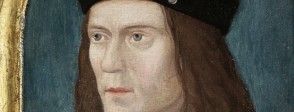As with any portrait, begin by discussing what students can tell about the person shown. You can begin in quite an open way, gathering responses both about status and wealth and about personality.
You can develop the discussion further by comparing several other portraits – there are examples in For the classroom. Invite students to identify similarities and differences. Focus the comparison on this portrait and the other from the Society of Antiquaries. Explain to the students that both portraits were possibly produced within five to ten years of each other and brainstorm what may account for the differences. Consider how the two portraits represent two sides of one story, in which Richard is both a classic medieval monarch conveying signs of wealth, status and majesty, and a defeated, deformed and deposed king. What historical questions and issues arise from this and what is a historian is to do in such a situation?
Look at some descriptions of Richard III such as those by Thomas More and by Shakespeare – you will find plenty on the websites given in More information. Compare these with the portrait. Do the students detect any echoes of the written descriptions in the visual representations? Discuss how both verbal and visual representations of people and events from the past often derive from a single or small number of originals and that therefore specific interpretations may be promulgated and become accepted as accurate.
Use the resources in For the classroom to investigate the changes to this portrait and to some of the others. How significant do the students think the changes are? The verbal descriptions of Richard are often quite extreme and it may be surprising to students that the portraits are quite restrained in their depiction of him both in terms of physical appearance and apparent character. Discuss why this might be. Explain that such portraits were often displayed in the homes of the nobility and the wealthy as sets of kings and queens. Does this help explain why the portraits were not altered more radically? Is there any reason for trusting verbal rather than visual sources in history?
After establishing the Tudor modifications of Richard’s appearance and reputation, discuss what this tells us about the Tudor regime at this time. Then introduce students to the eighteenth century alteration to the portrait of him with a broken sword. Why might this have taken place at this time? Look into the 1768 publication by Horace Walpole, ‘Historic Doubts on the Life and Reign of King Richard the Third’. The website of the Richard III Society also has information about the origins of some historic reassessment of Richard. Consider why the twentieth century saw such an interest in re-assessing the character of Richard.
Thinking History Activity 1 in For the classroom takes advantage of the fascinating story of the excavation of Richard’s skeleton to asks students to consider what different sorts of evidence can tell us and whether some historical questions are more important than others. Integrate work on the portraits into the activity to introduce another type of evidence and discuss what they contribute to historical investigation.
Thinking History Activity 2 in For the classroom focuses on the disappearance of the Princes in the Tower. Use the images from the Collection search in For the classroom to look at how the story is represented visually and see what differences the students can identify in different periods.
How important is it to know what Richard III really looked like?
The portrait provides a useful starting point for an enquiry into Richard’s image and the importance attached to it. Using the links in For the classroom students can find further portraits of Richard and descriptions of him from Tudor texts. Students should examine Tudor motives for this depiction of Richard, and could also look at the impact of Shakespeare’s characterisation of him. Use the discovery of Richard’s skeleton in Leicester and the subsequent analysis of it to evaluate the verbal and visual sources they have looked at. The outcome is likely to be that the restored Society of Antiquaries portrait has the best credentials to be an accurate likeness. Introduce the idea that no portrait represents the actual person unproblematically, but at best presents the image the sitter (or the person commissioning the portrait) wishes to see. Does this make any difference to the issue of which portrait looks most like Richard? Consider the various permutations generated by the concept of portraiture as motivated rather than neutral representation.
Who thought Richard a good king?
The dominant image of Richard has been as a villain. Explore this with the students looking at the images and resource links in For the classroom and look at the evidence, including his seizure of the throne and his likely murder of his rivals. Use the University of York website and the objects in A bigger picture to build up a contrasting picture of Richard. Discuss the extent to which Richard’s good work and support was localised in the north and consider how a historical figure can be seen differently in different regions. You might consider how it was that the negative image of Richard came to predominate.
Should we let the facts get in the way of telling a good story?
Using illustrations of Shakespeare’s play students can examine the dramatic impact of characterising Richard as a villain. There is a variety of video clips in For the classroom presenting fictionalised versions of Richard III’s story and documentaries, which are interesting to compare. Ask students to write a pitch to a production company for either a film based on a fictionalised retelling of Richard’s life or a documentary based on historical and archaeological sources. Ask students to ensure that in their pitch they justify their choice and predict the impact their film will have on public perceptions of late medieval British history.


